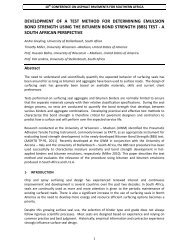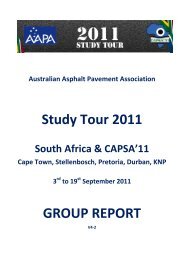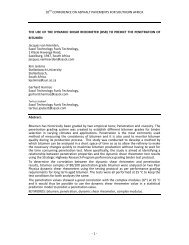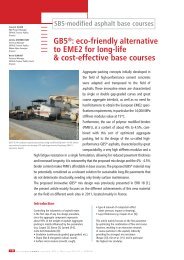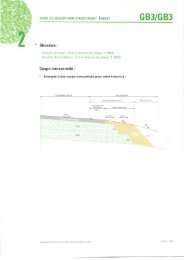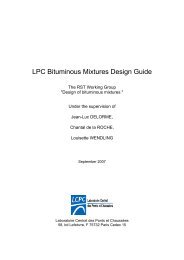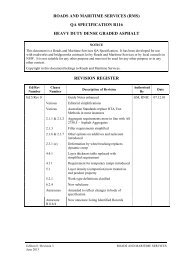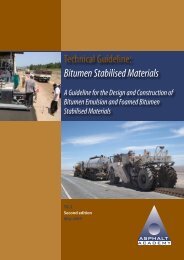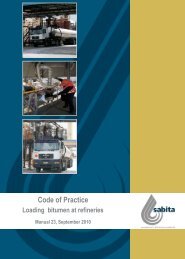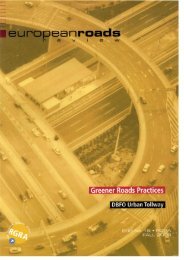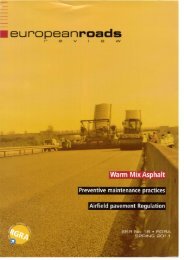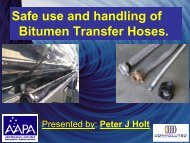Guide to the safe handling of solvents in a bituminous ... - Aapaq.org
Guide to the safe handling of solvents in a bituminous ... - Aapaq.org
Guide to the safe handling of solvents in a bituminous ... - Aapaq.org
- No tags were found...
You also want an ePaper? Increase the reach of your titles
YUMPU automatically turns print PDFs into web optimized ePapers that Google loves.
Fire will not be <strong>in</strong>itiated if any one <strong>of</strong> <strong>the</strong>se elements is absent, and will notbe susta<strong>in</strong>ed if one <strong>of</strong> <strong>the</strong>se elements is removed.This concept is useful <strong>in</strong> understand<strong>in</strong>g prevention and control <strong>of</strong> fires. Forexample, <strong>the</strong> coexistence <strong>of</strong> flammable vapours and ignition sourcesshould be avoided, but when flammable vapours cannot be controlledelim<strong>in</strong>ation <strong>of</strong> ignition sources is essential.• Classes <strong>of</strong> Fire: The National Fire Protection Association (NFPA -USA) has def<strong>in</strong>ed four classes <strong>of</strong> fire, accord<strong>in</strong>g <strong>to</strong> <strong>the</strong> type <strong>of</strong> fuel<strong>in</strong>volved. These are: Class A fires <strong>in</strong>volve combustibles such as paper, wood, cloth,rubber and many plastics; Class B fires entail burn<strong>in</strong>g <strong>of</strong> liquid fuels like oil-based pa<strong>in</strong>ts,greases, <strong>solvents</strong>, oil and gasol<strong>in</strong>e; Class C fires are <strong>of</strong> electrical orig<strong>in</strong> (fuse boxes, electric mo<strong>to</strong>rs,wir<strong>in</strong>g); Class D fires encompass combustible metals such as magnesium,sodium, potassium and phosphorus.• Fire ext<strong>in</strong>guishers: Fire ext<strong>in</strong>guishers are rated as A, B, C or D (orcomb<strong>in</strong>ations <strong>of</strong> A, B, C and D) for use aga<strong>in</strong>st <strong>the</strong> different classes <strong>of</strong>fires. Personnel should familiarise <strong>the</strong>mselves with <strong>the</strong> fire classrat<strong>in</strong>gs <strong>of</strong> <strong>the</strong> ext<strong>in</strong>guishers <strong>in</strong> <strong>the</strong>ir work areas so that <strong>the</strong>y know whattypes <strong>of</strong> fire <strong>the</strong>y can attempt <strong>to</strong> ext<strong>in</strong>guish with each particularext<strong>in</strong>guisher. They should learn how <strong>to</strong> use each type <strong>of</strong> ext<strong>in</strong>guisher,as <strong>the</strong>re will be no time <strong>to</strong> read <strong>in</strong>structions dur<strong>in</strong>g an emergency.They should attempt <strong>to</strong> fight small fires only, and only if <strong>the</strong>re is anescape route available. It is important <strong>to</strong> have <strong>the</strong> ext<strong>in</strong>guisherrecharged after every use. If <strong>the</strong> necessity does arise <strong>to</strong> fight a fire,personnel should remember <strong>the</strong> acronym “PASS” when us<strong>in</strong>g <strong>the</strong>ext<strong>in</strong>guisher: P: Pull and twist <strong>the</strong> lock<strong>in</strong>g p<strong>in</strong> <strong>to</strong> break <strong>the</strong> seal; A: Aim low, and po<strong>in</strong>t <strong>the</strong> nozzle at <strong>the</strong> base <strong>of</strong> <strong>the</strong> fire; S: Squeeze <strong>the</strong> handle <strong>to</strong> release <strong>the</strong> ext<strong>in</strong>guish<strong>in</strong>g agent; S: Sweep from side <strong>to</strong> side until <strong>the</strong> fire is out;52



